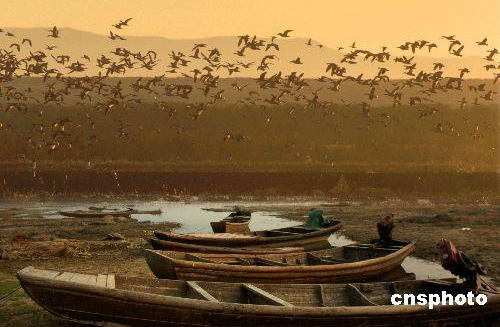
(Ecns.cn) – Poyang Lake, China's largest freshwater lake and an internationally significant wetland area, has long provided a habitat for migratory birds. But in recent years, this ideal winter haven has instead become a destination fraught with risks for many endangered species.
Over the past two decades, poachers have used every means available to hunt birds at Poyang, and some rare species such as swans and cranes have ended up on restaurant menus, said the Southern Metropolis Daily.
According to estimates, the current number of migratory birds that fly to Poyang for winter has been reduced by 90 percent from ten years ago. Some people have compared the current state of the Poyang to China's Hoh Xil area on the Tibetan plateau, where the poaching and slaughter of wildlife prevails despite countermeasures.
Cruel traps
It was on February 12, 2012, a cloudy day in Nanchang of east China's Jiangxi Province, when the provincial government received a phone call reporting a case of bird poaching.
Officials from the provincial forestry department and the Poyang Wildlife Protection Center soon formed a team and began an investigation. After arriving at the scene spread across Duchang and Xinjian Counties, they found several bags of swan geese and white cranes, both of which are waterfowl under national protection.
Zhu Yungui, director of the Wildlife Protection Bureau under the Jiangxi provincial forestry department, said he was heartbroken by the sight of so many killed rare species.
Fortunately, a growing number of people are stepping up and making grassroots efforts to deal with the problem that has escaped comprehensive government action.
Just this month, a group of bird lovers from all across the nation have begun volunteering to protect waterfowl at Poyang Lake. They chose this time because the dry season is especially bad this year; water levels have shrunk dramatically, resulting in larger areas of shallow marshland that are particularly beneficial to bird poachers.
The conditions cause waterfowl to leave claw prints that are easier to detect in the places where they forage for food, making it simpler for poachers to decide where to place glue traps.
The volunteers have their work cut out for them; they usually walk up to 70 or 80 kilometers a day to record bird movement and look out for any abnormal activity.
They say the glue traps are a very simple but effective tool used to entangle birds. During a recent patrol of the Poyang, they found a large number of traps that had been set up out of sight. In some places, many waterfowl had suffered miserably; their necks were wrapped in silk-thin threads, indicating that the birds had struggled for some time before dying.
Crossing the line
Huang Xianyin, a conservationist from Henghu Township near Poyang Lake, has considered the task of protecting waterfowl a solemn duty since December 2005, when he tried and failed to rescue a poisoned white crane.
A man with a strong affection for animals, Huang is angry that some of his fellow villagers are crossing the line and slaughtering dozens of migratory birds every year.
He says hunting has a long history in his village. In the old days, poor villagers caught swans and gave them to relatives as gifts. Nowadays, many residents who have inherited the skill of poaching and slaughtering waterfowl are selling the birds for profit, and their techniques are being improved every day.
Huang says the glue traps are the most common method, but local poachers also use floodlights, rolling hooks and poison. Between 2005 and 2006, the overuse of poison for bird poaching even resulted in the deaths of several cows that belonged to local villagers.
Market demand
Though a series of measures have been adopted to stop wildlife slaughter and illegal trading, the problem has not abated.
The primary reason for this is the food industry in China's southern provinces, where restaurants continue to secretly serve wild animal meat at high prices, creating a stimulus for poachers looking to make a quick buck.
A small swan sells for as much as 2,000 yuan (US$318) at a local black market ahead of Spring Festival. That price can rise to over 10,000 yuan (US$1,588) after it is delivered to Guangzhou, Shenzhen or Hangzhou, an insider told the Southern Metropolis Daily.
Such profits are half a year's earnings for an ordinary fisherman. Under such circumstances, criminal gangs have been established solely for the wild game trade, even though related laws stipulate that those who kill or transport wild animals under second-class state protection are subject to severe punishment.
The government should more effectively enforce those regulations to stop such practices immediately, and also pay subsidies or other forms of compensation to local fishermen, in order to help them develop a diversified economy and increase their incomes while also preserving the ecosystem.

Copyright ©1999-2011 Chinanews.com. All rights reserved.
Reproduction in whole or in part without permission is prohibited.